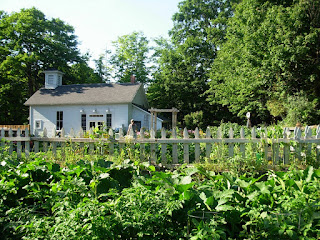An opportunity to become self sufficient

Schoolhouse Farms is Diversity and a Traditional Farm
A family dedicated to sowing growing and sharing in the hills of Borodino New York
Nobody really knows where or if the agrarian trait actually resides in each of us. In some of us it is an obvious and dominant trait that leads us naturally to agricultural pursuits. For others it is such a recessive trait buried so deeply in the psyche it is never unearthed. Finally for another group it is a late developing recessive trait that takes root as the result of an internal or external trigger mechanism which acts to catapult the agrarian trait to the forefront and the consequent yearning to become dominant. In our family we believe that the agrarian trait was always primarily dominant but due to social pressures and our societies materialistic tendency it was pushed way back to an unnatural recessive position. For the majority of citizens and immigrants the “American Dream” is to live large, accumulate mountains of wealth and to buy and possess more stuff then our neighbors in an effort to achieve some undefined level of success. In the late 1800’s it was environmentalist John Muir who plainly stated "Everybody needs beauty as well as bread, places to play in and pray in where Nature may heal and cheer and give strength to body and soul alike." He went on to lament “I am degenerating into a machine for making money” Life for him and many that followed was simply much more then the mass accumulation of material possessions it was about the soul and the harmony of nature and things that spring forth from the earth. It was time to get back to the goodness of the land.
Growing sustainable agriculture the raising and nurturing of our family and sharing the seasonal bounty with family and friends are our farms chief aim. Plus by being energetic and creative we may be able to earn a little stream of income. In our effort to achieve our dreams it has become more important for us to diversify our small farm into a more traditional style operation, a farm diverse and sufficient enough to sustain an edible future for our family. Our agrarian focus has been sharpened by circumstance that we gladly embrace. The economic down turn has impacted millions in all walks of life and we are no exception. We simply took it as the opportune time to more deeply embrace our agro passion. The monotonous yet financial advantages of the corporate job were really an impediment to our agrarian pursuits. Simply stated it took man power away from the farm. Granted it will require considerable sacrifice by all members of the family and will mean that less will simply have to go farther. It will also mean that the children will have to endure some chiding in the social circles and in some cases will have to pass on participating in certain activities. They understand this and are prepared to shoulder the less then stellar commentary of their peers for the opportunity to embrace the project and strengthen the family unit. They will as a result of this agrarian immersion develop a healthier appreciation of foods and the creative process associated with its production. Our priorities may not align with the masses but then again we have never really been ones who run with the herd. The reality is we enjoy family time and it is a fleeting and finite opportunity that too many families fail to embrace. An opportunity to become self sufficient, with diverse and creative outlets learning about fabulous eating from field to plate while instilling an education!
Apples, beans, chickens, beets, quince, pork, grains, black currants, lettuce, chard, rhubarb, sun flowers, squash, eggs, raspberries potatoes, wine and jam all grown and made on the farm. A diverse source of products each linked to each others success as well as providing us with an almost endless source of creativity. The traditional farm is unique in its operation because the diversity of the products makes the farm sustainable on a much smaller scale. This economy of scale also allows for a much tinier carbon foot print as large diesel machines simply don’t fit into these operations. The trade off for fossil fuel is labor. It takes quite a few pairs of hand to get tasks complete from the initial cultivation and mulching of the fields to the sowing of seeds the weeding of the rows and then the harvesting. The education that comes with learning how to grow diversity is observable on a daily basis as each product has varied and different attributes. The project yields its own rewards as a season filled with perspiration generates stimulating conversation which creates emotional inspiration and thus leads to a form of advanced education. The continuous education of the entire family takes place by osmosis as we literally absorb what is going on around us. At gatherings of family and friends we disseminate all that we have absorbed to the group and the education continues to spread and infiltrate and diversify. When the season ends and the deepest coldest portion of winter once again descend upon our region the local mailman starts delivering the latest and greatest in seed and agriculture catalogs. Although delivered during the chilly Borodino winter our small traditional farm takes special notice at the next semester’s diverse class list and accompanying syllabus. So many, many seeds and breeds where does one begin?


Comments